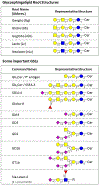Recent Advances in the Mass Spectrometry Methods for Glycomics and Cancer
- PMID: 29049885
- PMCID: PMC6200424
- DOI: 10.1021/acs.analchem.7b04202
Recent Advances in the Mass Spectrometry Methods for Glycomics and Cancer
Abstract
Figures









References
-
- Sethi MK; Kim H; Park CK; Baker MS; Paik YK; Packer NH; Hancock WS; Fanayan S; Thaysen-Andersen M, In-depth N-glycome profiling of paired colorectal cancer and non-tumorigenic tissues reveals cancer-, stage- and EGFR-specific protein N-glycosylation. Glycobiology 2015, 25 (10), 1064–78. - PubMed
-
- Holst S; Wuhrer M; Rombouts Y, Glycosylation characteristics of colorectal cancer. Adv Cancer Res 2015, 126, 203–56. - PubMed
-
- Meezan E; Wu HC; Black PH; Robbins PW, Comparative studies on the carbohydrate-containing membrane components of normal and virus-transformed mouse fibroblasts. II. Separation of glycoproteins and glycopeptides by sephadex chromatography. Biochemistry 1969, 8 (6), 2518–2524. - PubMed
Publication types
MeSH terms
Substances
Grants and funding
LinkOut - more resources
Full Text Sources
Other Literature Sources

